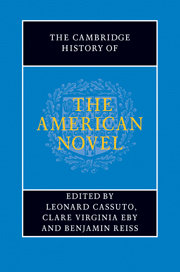Book contents
- Frontmatter
- General Introduction
- PART ONE INVENTING THE AMERICAN NOVEL
- PART TWO REALISM, PROTEST, ACCOMMODATION
- PART THREE MODERNISM AND BEYOND
- PART FOUR CONTEMPORARY FORMATIONS
- Introduction: contemporary formations
- 58 Postmodern novels
- 59 The nonfiction novel
- 60 Disability and the American novel
- 61 Model minorities and the minority model – the neoliberal novel
- 62 The American borderlands novel
- 63 The rise of the Asian American novel
- 64 Toni Morrison and the post-civil rights African American novel
- 65 Hemispheric American novels
- 66 The worlding of the American novel
- 67 The Native American Tradition
- 68 Contemporary ecofiction
- 69 Graphic novels
- 70 Twentieth- and twenty-first-century literary communities
- 71 A history of the future of narrative
- A selected bibliography
- Index
59 - The nonfiction novel
from PART FOUR - CONTEMPORARY FORMATIONS
Published online by Cambridge University Press: 28 July 2011
- Frontmatter
- General Introduction
- PART ONE INVENTING THE AMERICAN NOVEL
- PART TWO REALISM, PROTEST, ACCOMMODATION
- PART THREE MODERNISM AND BEYOND
- PART FOUR CONTEMPORARY FORMATIONS
- Introduction: contemporary formations
- 58 Postmodern novels
- 59 The nonfiction novel
- 60 Disability and the American novel
- 61 Model minorities and the minority model – the neoliberal novel
- 62 The American borderlands novel
- 63 The rise of the Asian American novel
- 64 Toni Morrison and the post-civil rights African American novel
- 65 Hemispheric American novels
- 66 The worlding of the American novel
- 67 The Native American Tradition
- 68 Contemporary ecofiction
- 69 Graphic novels
- 70 Twentieth- and twenty-first-century literary communities
- 71 A history of the future of narrative
- A selected bibliography
- Index
Summary
Nicholas Branch sits in the book-filled room, the room of documents, the room of theories and dreams. He is in the fifteenth year of his labor and sometimes wonders if he is becoming bodiless. He knows he is getting old.
Anyone writing about the nonfiction novel will sympathize with Nicholas Branch, the retired CIA analyst in Don DeLillo's Libra (1988) who has been hired to write the definitive history of the Kennedy assassination. The problem facing the student of the nonfiction novel is not only ontological but also practical: like Branch, one faces a mountain of material that grows bigger all the time, because in both theory and practice it is difficult to write about the nonfiction novel without also discussing a range of associated discourses and genres, including the fictive novel, the documentary novel, the historical novel, historiographic metafiction, and (New) journalism. In order to avoid the entropy that threatens to overwhelm Branch, I want to propose that (1) these genres are all concerned with what it means to represent reality; (2) these genres often express this concern with reality through attempts to give narrative form to that which is violent and/or traumatic; and (3) that the nonfiction novel genre has proven itself particularly adept at exploring the impact of violence on the representation of reality. My intent is less to define a genre in narrow terms and more to anatomize the attitudes and anxieties about the relation between fact and fiction in narrative that have collected around the term “nonfiction novel.”
Does the representation of violence provide the nonfiction novel with an opportunity to distinguish itself, to establish its own specificity in relation to other forms of prose narrative? In his essay on the Kennedy assassination, “American Blood,” DeLillo argues that “violence itself seems to cause a warp in the texture of things.” Perhaps the nonfiction novel is better equipped than other prose genres to delineate the shape of that warp?
- Type
- Chapter
- Information
- The Cambridge History of the American Novel , pp. 986 - 1001Publisher: Cambridge University PressPrint publication year: 2011
- 1
- Cited by



